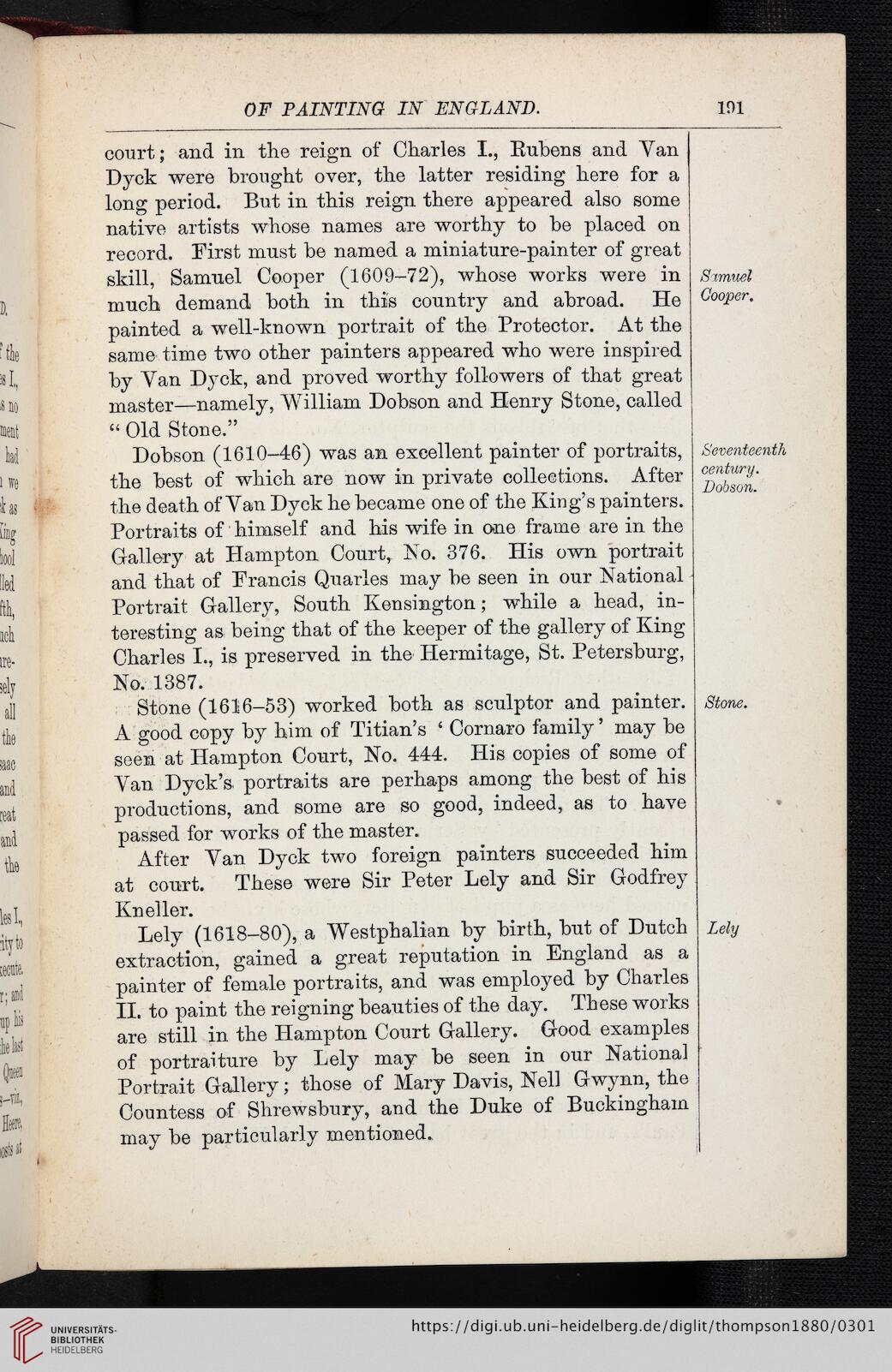OF PAINTING IN ENGLAND.
191
court; and in the reign of Charles I., Rubens and Van
Dyck were brought over, the latter residing here for a
long period. But in this reign there appeared also some
native artists whose names are worthy to be placed on
record. First must be named a miniature-painter of great
skill, Samuel Cooper (1609-72), whose works were in
much demand both in this country and abroad. He
painted a well-known portrait of the Protector. At the
same time two other painters appeared who were inspired
by Van Dyck, and proved worthy followers of that great
master—namely, William Dobson and Henry Stone, called
“ Old Stone."
Dobson (1610-46) was an excellent painter of portraits,
the best of which are now in private collections. After
the death of Van Dyck he became one of the King's painters.
Portraits of himself and his wife in one frame are in the
Gallery at Hampton Court, No. 376. His own portrait
and that of Francis Quarles may be seen in our National
Portrait Gallery, South Kensington; while a head, in-
teresting as being that of the keeper of the gallery of King
Charles I., is preserved in the Hermitage, St. Petersburg,
No. 1387.
Stone (1616-53) worked both as sculptor and painter.
A good copy by him of Titian's ' Cornaro family' may be
seen at Hampton Court, No. 444. His copies of some of
Van Dyck's portraits are perhaps among the best of his
productions, and some are so good, indeed, as to have
passed for works of the master.
After Van Dyck two foreign painters succeeded him
at court. These were Sir Peter Lely and Sir Godfrey
Kneller.
Lely (1618-80), a Westphalian by birth, but of Dutch
extraction, gained a great reputation in England as a
painter of female portraits, and was employed by Charles
II. to paint the reigning beauties of the day. These works
are still in the Hampton Court Gallery. Good examples
of portraiture by Lely may be seen in our National
Portrait Gallery; those of Mary Davis, Nell Gwynn, the
Countess of Shrewsbury, and the Duke of Buckingham
may be particularly mentioned..
Samuel
Cooper.
Seventeenth
century.
Dobson.
Stone.
Lely
191
court; and in the reign of Charles I., Rubens and Van
Dyck were brought over, the latter residing here for a
long period. But in this reign there appeared also some
native artists whose names are worthy to be placed on
record. First must be named a miniature-painter of great
skill, Samuel Cooper (1609-72), whose works were in
much demand both in this country and abroad. He
painted a well-known portrait of the Protector. At the
same time two other painters appeared who were inspired
by Van Dyck, and proved worthy followers of that great
master—namely, William Dobson and Henry Stone, called
“ Old Stone."
Dobson (1610-46) was an excellent painter of portraits,
the best of which are now in private collections. After
the death of Van Dyck he became one of the King's painters.
Portraits of himself and his wife in one frame are in the
Gallery at Hampton Court, No. 376. His own portrait
and that of Francis Quarles may be seen in our National
Portrait Gallery, South Kensington; while a head, in-
teresting as being that of the keeper of the gallery of King
Charles I., is preserved in the Hermitage, St. Petersburg,
No. 1387.
Stone (1616-53) worked both as sculptor and painter.
A good copy by him of Titian's ' Cornaro family' may be
seen at Hampton Court, No. 444. His copies of some of
Van Dyck's portraits are perhaps among the best of his
productions, and some are so good, indeed, as to have
passed for works of the master.
After Van Dyck two foreign painters succeeded him
at court. These were Sir Peter Lely and Sir Godfrey
Kneller.
Lely (1618-80), a Westphalian by birth, but of Dutch
extraction, gained a great reputation in England as a
painter of female portraits, and was employed by Charles
II. to paint the reigning beauties of the day. These works
are still in the Hampton Court Gallery. Good examples
of portraiture by Lely may be seen in our National
Portrait Gallery; those of Mary Davis, Nell Gwynn, the
Countess of Shrewsbury, and the Duke of Buckingham
may be particularly mentioned..
Samuel
Cooper.
Seventeenth
century.
Dobson.
Stone.
Lely




